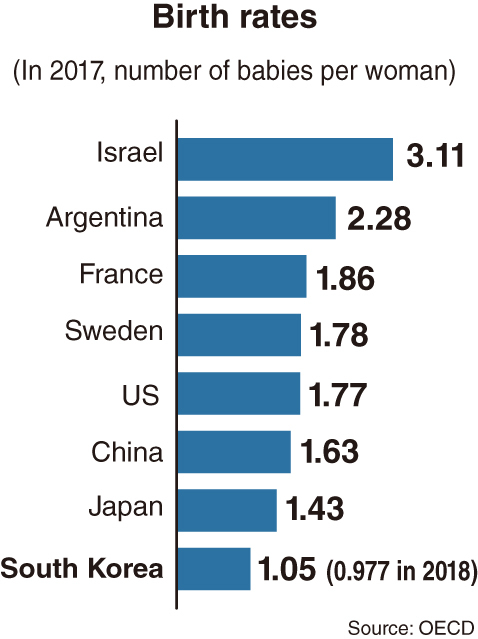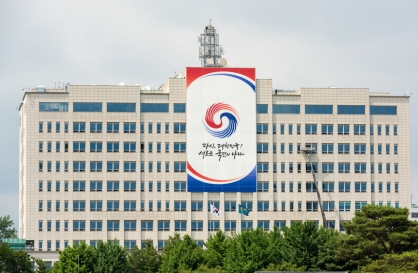SEJONG -- The number of South Koreans aged 14 or under accounted for only 12.5 percent of the total population as of October 2019, according to the Ministry of Interior and Safety.
The demographic database held by the ministry includes classification into three groups -- those aged up to 14, those aged 15-64 (called the working-age population) and those aged 65 or over (the senior population).
The data showed that the percentage of the youngest generation has continued to fall over the past decade: The figures were 14.2 percent five years earlier in October 2014 and 16.7 percent in October 2009.
The number for the age group up to 14 also declined to 6.49 million in October 2019 -- from 7.28 million in October 2014 and 8.28 million in October 2009 -- though the total population was still increasing during the 2009-2019 period.
 |
A TV commercial, provided by the Korea Broadcast Advertising Corp., is targeted to promote childbirths. (kobaco) |
The sharp reduction in the number and percentage of the youngest generation reflects the nation’s sliding birthrate, which means the number of expected children per woman, aged 15-49.
On a yearly basis, Korea recorded a birthrate of 1.654 in 1993, when the government officially started compiling of the data. The figure was still regarded as an endurable level in terms of backing up the potential working-age population, though it is estimated to have surpassed 2.0 in the early 1980s and 4.0 in the early 1970s, according to unofficial statistics.
But the birthrate posted a further decline in the 1990s and 2000s to come down to 1.187 in 2013. The figure for 2018 fell below the 1.0 mark for the first time in history at 0.977, according to Statistics Korea.
Among 17 major cities and provinces, Seoul posted the lowest of 0.761 last year, in line with its quickly decreasing population over the past decade.
Busan ranked second from bottom with 0.899, followed by Daejeon with 0.952, Gwangju at 0.972, Daegu with 0.987, Gyeonggi Province at 1.002, Incheon with 1.006 and North Jeolla Province at 1.044. The highest among the 17 areas was Sejong, reported as 1.566.
Some foreign news outlets have recently highlighted the seriousness of the situation in South Korea, citing its lowest fertility in the world. The Organization for Economic Cooperation and Development has compiled the 2017 data of birthrates for 36 OECD members and some nonmembers.
According to OECD Social and Welfare Statistics, South Korea posted the lowest birthrate figure of 1.05 in 2017 among 52 economies, while there was no other country that posted under 1.25. Except for Malta at 1.26, all the other countries reported figures greater than 1.3.
 |
(Graphic by Kim Sun-young/The Korea Herald) |
Korea far fell behind major Asian countries in birthrate numbers -- 1.43 in Japan, 1.63 in China, 2.3 in India, 2.34 in Indonesia and 2.49 in Saudi Arabia – as well as compared to Scandinavian nations -- 1.62 in Norway, 1.75 in Denmark and 1.78 in Sweden.
The figures for English-speaking countries were 1.74 in the UK, 1.74 in Australia, 1.77 in the US and 1.81 in New Zealand, while Mexico, Brazil and Argentina posted 2.15, 1.71 and 2.28, respectively.
Israel recorded a birthrate of 3.11 in 2017, trailed by South Africa at 2.43, Turkey at 2.07, France at 1.86, Netherlands at 1.62, Germany at 1.57, Bulgaria at 1.56, Switzerland at 1.52, Croatia at 1.42 and Italy marking 1.32.
The averages for the 28-member European Union and the 36-member OECD were 1.6 and 1.7, respectively.
Private think tanks as well as government officials in Korea are expressing significant fears about the nation’s workforce and growth potential in the coming decades, and it appears that recent demographic changes lend weight to those concerns.
Further, Koreans aged 9 or under recorded 4.18 million as of October 2019, putting this age group at the bottom of the rankings among seven different age groups marked by decade under 70, amid the record-low births.
“More people in their 20s and 30s are avoiding marriage or childbirth in the wake of their frustration over a tough job market and skyrocketing apartment prices (in Seoul particularly), and the like,” said a research fellow in Sejong.
Some think tanks like LG Economic Research Institute have forecast that the shrinking workforce will cut the nation’s GDP growth by up to 0.5 percentage point per annum in the coming decade.
By Kim Yon-se (
kys@heraldcorp.com)








![[Kim Seong-kon] Democracy and the future of South Korea](http://res.heraldm.com/phpwas/restmb_idxmake.php?idx=644&simg=/content/image/2024/04/16/20240416050802_0.jpg)
